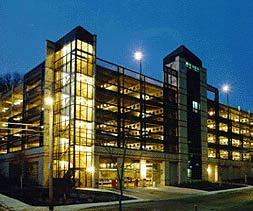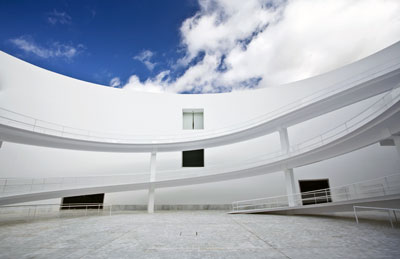Cast-in-Place Concrete Parking Structures
Advantages
Parking Structures | Advantages | Notable Projects

Crack Control and Watertightness
Deflection and Vibration Control
Enhanced Lighting and Patron Security
Initial and Life Cycle Costs
Analyses and competitive bids against alternative systems often show that post-tensioned structural systems provide initial cost savings. Alternative bids for the Indianapolis International Airport Parking Structure resulted in a savings of about $1.00 per square foot for the post-tensioned alternative. When initial costs are more closely comparable, life cycle costs often show savings for post tensioned alternatives.
Low Maintenance Cost
Properly constructed cast-in-place posttensioned concrete floors are virtually crackfree and use widely-spaced floor joints (joint spacings of 200 ft or more are common). The use of epoxy-coated reinforcement, encapsulation of post-tensioned reinforcement, low water/cement ratio air-entrained concrete, and concrete sealers in aggressive environments provide floor systems with minimal maintenance costs. Precast floors, particularly "untopped" precast floors, require periodic maintenance repairs of the caulked joints between the precast units. One consulting firm estimated that 30 percent of the caulked joints of precast floors will need to be replaced every three years after the five-year warranty expires. Loss of parking spaces during maintenance work results in loss of parking revenue.
Crack Control and Watertightness
In addition to eliminating caulked joints, post-tensioning helps achieve watertightness by introducing a state of bi-axial compression in the slab, thereby controlling cracks. This is an important advantage because water, dirt and de-icer chemicals leaking through cracks or joints may make parts of a parking structure unusable or require costly repairs.
Functional Flexibility
 Cast-in-place, post-tensioned concrete construction provides long, column-free spans and is easily adaptable to the framing and functional requirements of parking structures. Post-tensioned construction easily accommodates the framing requirements of straight ramps, curved ramps, and irregular sites. There is no functional compromise, which can be the case with other framing systems.
Cast-in-place, post-tensioned concrete construction provides long, column-free spans and is easily adaptable to the framing and functional requirements of parking structures. Post-tensioned construction easily accommodates the framing requirements of straight ramps, curved ramps, and irregular sites. There is no functional compromise, which can be the case with other framing systems.
Reduced Structural Depth
Use of post-tensioning reduces the depth of the floor system by one third or more in comparison to some alternative systems. Reduced structural depth enhances both the appearance and economy of post-tensioned concrete parking structures. In some cases, depth reduction is an essential factor in meeting code height restrictions. For underground parking structures, reduced depth reduces excavation and shoring costs as well as improving parking efficiency due to shorter ramps.
Deflection and Vibration Control
Because of their draped configuration, the tendons in a post-tensioned structure carry much of the load directly to the columns. This reduces flexural deflections in the framing system. Due to post-tensioning, the entire concrete section is effective in resisting load effects. In conjunction with the redundancy of monolithic concrete framing systems, this reduces vibrations of the completed structure.
Enhanced Lighting and Patron Security

The wide beam spacing and flat surfaces provided by cast-in-place parking structures enhance the installation and efficiency of the lighting system. This results in improved aesthetics and enhanced patron security.
Fire Resistance
The fire-resistant characteristics of the flat surfaces and wide beams of post-tensioned structures provide fire-resistance ratings to meet code requirements. Concrete insulation delays the strength loss of the main reinforcement. Thin-stemmed structural elements provide less concrete insulation, resulting in shorter fire-resistant periods.
Aesthetics
The architectural appeal of cast-in-place concrete construction is widely recognized. In fact, structures with other framing systems often imitate cast-in-place concrete parapets and fascia. Curvilinear shapes and forms economically achievable in cast-in-place structures provide the necessary flexibility for creative architectural expressions.
 The aesthetic advantages of cast-in-place concrete parking structures are demonstrated in project case studies. The ease with which architectural treatments of exposed concrete are achieved is a definite advantage of cast-in-place concrete structures. A notable example is the Williams Square West Garage in Irving, Texas, shown above. In this structure, the concrete in exposed perimeter elements was made with a crushed granite aggregate. The concrete for the interior beams, slabs and columns used a more economical crushed limestone aggregate. To fully reveal the color of the granite, perimeter surfaces were sandblasted.
The aesthetic advantages of cast-in-place concrete parking structures are demonstrated in project case studies. The ease with which architectural treatments of exposed concrete are achieved is a definite advantage of cast-in-place concrete structures. A notable example is the Williams Square West Garage in Irving, Texas, shown above. In this structure, the concrete in exposed perimeter elements was made with a crushed granite aggregate. The concrete for the interior beams, slabs and columns used a more economical crushed limestone aggregate. To fully reveal the color of the granite, perimeter surfaces were sandblasted.


